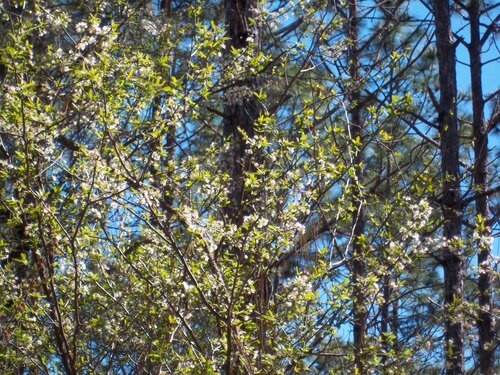Chickasaw Plum
Prunus angustifolia
© Todd Fitzgerald, some rights reserved (CC-BY-NC)
Chickasaw Plum, (Prunus angustifolia), is a thicket-forming tree that grows to about 25 feet tall and produces white flowers and yellow to red fruit from August through September. The tree also produces thorn-like side branches. It is deciduous and is a member of the rose family (Rosaceae). The fruits are eaten but, apparently, are rather tart. They are often made into jams and jellies.
This species is native to most of eastern America and has been introduced into areas where it previously was not often found. It is found in woodland edges, forest openings, meadows, roadsides, and savannas. It is best grown in hardiness zones 5 through 9.
The Chickasaw plum does best in full sun, low to medium water conditions, and sandy, loose soils.
Habitat Value
This interesting, aromatic plant provides cover and resting places for many animals, including birds, and mammals. The fruits are eaten by both birds and mammals and several insects visit the flowers, including pollinating bees.
Several problem diseases impact this species, including several fungi, aphid borers, black knot, and tent caterpillars. This species has low poison characteristics.
© hollyyoung, some rights reserved (CC-BY-NC); © Ron Stephens, some rights reserved (CC-BY-NC); © oliviaeortiz, some rights reserved (CC-BY-NC)
Landscape Value
Written by Ryan Wang for WMWA Landscape Architects
Chickasaw Plum is a multi-branch shrub or small tree usually in a form of a thicket. Its March blossoms are perhaps the first native showy blooms to emerge for our region. The yellow-ish red plums ripen in early to mid-summer, and the tart flavor is great for jams and preserves. This species is low maintenance, but make sure to remove root suckers to stop unwanted lateral growth or leave it plenty of room to spread. Often found in sunny woodlands, wild areas, and stream banks, this plant is best used for informal screens, windbreaks, hedges, and erosion control. In addition, the plant has extensive wildlife values, offering protective cover from predators and nesting habitats for critters. Chickasaw Plum also serves as a larval host for several butterflies and provides nectar for pollinators, while the fruits are often eaten by birds and small mammals.





